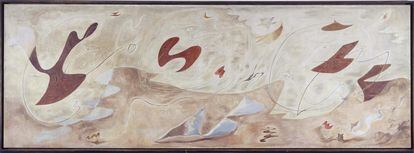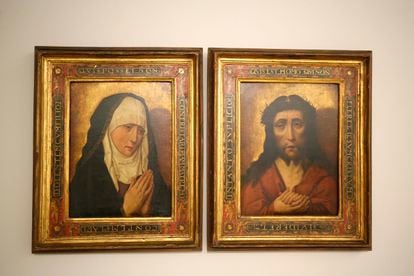The ideological fury of the Nazis was also a master key to endless theft. From the heart of the Third Reich, a systematic theft of works of art from private and public collections throughout Europe was planned, starting with German Jewish families. The latest information on the Nazi looting is that a California Court has concluded that the Thyssen Museum is the legitimate owner of Rue Saint-Honoré in the afternoon. rain effectan 1897 oil painting by Camille Pissarro.
The litigants over the ownership of the painting for almost 25 years are the descendants of Lilly Cassirer, her Jewish great-grandmother, who in 1938 was forced to sell the painting at a low price to obtain a visa and flee Germany. “The Cassirer family has already said that they are going to continue appealing, so there is a lot of cloth to cut and years of battle ahead,” Bernardo Cremades Jr, of the Spanish law firm that is part of the case representing several Spanish Jewish associations.
The debate, which transcends borders, goes back a long way. For years, Anne Webber, president of the Commission for Looted Art in Europe, has insisted that you have to be meticulous about what you buy. “It is a matter of public interest that works looted from people in the most horrible circumstances hang on the walls of our museums like the last prisoners of war,” she said in an interview with Guardian in the year 2000.
Precisely between the nineties and 2000, an investigation carried out by journalist Héctor Feliciano opened the debate on the question of ownership and whereabouts of looted paintings. At that time this issue “was an open chapter, with a lot of secrecy. Almost no one from the art world wanted to talk about it,” he explains. For eight years, Feliciano, cultural correspondent in Europe for North American newspapers Washington Post and Los Angeles Times, followed the clues of a puzzle with most of the pieces lost and almost no collaboration from authorities and museums. The result was The missing museum (Destino, 2004), an investigation that caused great impact in the French artistic and cultural community, first, and in the rest of Europe and the United States later.
Now, 20 years later, “a lot of progress has been made” according to Feliciano, but the wounds remain open. “A museum, by definition, is out of context with respect to its works, and talking is very important. You have to open a dialogue, know the biography of each work of art and the history woven into it. Also that of the Pissarro painting,” he reflects on the phone.
Miguel Martorell, author of Nazi looting (Galaxia Gutemberg, 2020), also abounds in this idea. From the beautiful oil Rue Saint-Honoré in the afternoon. rain effect – which Pissarro painted from the window of his hotel in the Place du Théâtre Français, in Paris – says: “we cannot forget where it comes from and what it means. Normal market logic should not be applied, because its history is linked to the Holocaust.”
In Spain there have been two cases of litigation related to Nazi looting, with happier endings: last year the Museum of Pontevedra returned to Poland two altarpieces from the 15th century attributed to the painter Dieric Bouts stolen during the war, and a few years ago the Museo Nacional Centro de Arte Reina Sofía reached an agreement with the descendants of David Weil, claimants of the work The family in metamorphosisby the surrealist André Masson, and kept the painting.

According to the Washington Principles, signed by Spain along with 43 other countries in 1998, governments are responsible for investigating the history of works of art in their museums during the period of Nazi looting and, in the event of claims, they undertake to reach a “fair” agreement for all parties in conflict: return, compensation or historical recognition.
Memory and plunder
This type of litigation goes beyond a question of buying and selling. Stealing the best creations was Hitler's dream to create the best museum in the world in Linz (Austria), but there were other objectives. For example, systematically erasing all traces of Jewish memory through a policy of requisitions of his works of art, but also of everyday objects such as clothing, toys or light bulbs. In January 1933, shortly after becoming chancellor of Germany, Hitler—who as a young man saw his application to enter the Academy of Fine Arts in Vienna rejected twice—warned at a meeting in Stuttgart that it was “a mistake.” think that the national revolution is only political and economic. It is above all cultural.”
According to the study The Nazi looting: a looting with a 'replacement' (University of Barcelona, 2009), by Jone Sarriegui, the Nazi purges in creation bear similarities to the idea of racial purge. They began in the field of art, considering Dadaist, Cubist, Expressionist or Surrealist paintings “impure” or “degenerate”, all of them foreign to the “classical” canon imposed by Nazism. In this way, the new ideology dictated that art should be healthy either pure, full of Central European landscapes, industrious artisans or beautiful women of Aryan appearance. “A selection is made of those works that are of interest and the rest is eliminated or sold (or bartered). Just as there is an exaltation of the Aryan and those who do not fit into those canons are denigrated, persecuted or eliminated (Jew, gypsy, homosexual…), in the same way non-'Germanic' art will be persecuted and eliminated,” Sarriegui argues.
Under this premise, the program of theft, confiscation, looting and plundering of art objects and other cultural properties of Nazi Germany reached unprecedented levels. A 1944 document from the Einsatzstab Reichsleiter Rosenberg (ERR)—Special Detachment of the Reich leader Rosenberg for the Occupied Territories, under the orders of Alfred R
osenberg, ideologist of Nazism—, estimated at 21,903 the works that they seized in France, including paintings, sculptures, furniture, tapestries and small art objects. small ones like jewelry or porcelain. And Feliciano's investigations certified that during the war years, 29 convoys loaded with 100,000 paintings, sculptures and drawings left France for Germany. In total, 203 art collections passed into German hands, which represented approximately a third of the art that was then in private French hands.

Between 1944 and 1945, some of the works looted throughout Europe were stored in a rehabilitated abandoned salt mine full of tunnels and galleries, in Altaussee, a town in the Austrian Alps. When the war ended, the Allies and the Monuments, Fine Arts and Archives subdivision—known as the Monument Men—found the mine and the lavish treasure, which consisted of 6,755 paintings by old masters such as Michelangelo, Velázquez, Rubens, Tintoretto , Rembrandt, Goya or a Gioconda false – a deception by the French to pacify the voracious Nazi appetite -, in addition to 1,039 engravings, 230 watercolors, 95 tapestries, 68 sculptures, 43 containers with small works of art and another 358 containers with books.
This astonishing spider web of looting was woven by senior Nazi officials, but it involved soldiers, dealers, antique dealers, collectors, museum directors and unscrupulous hustlers. Beyond stealing, some bet on the art of deception. There is the case of Han van Meegeren, a painter who copied works of art and who became a multimillionaire taking advantage of the lack of knowledge about the work of Vermeer, one of the Nazis' favorite artists. yesaccording to research that began in the seventies with Marijke van den Brandhof.
Han van Meegeren even invented a supposed “religious stage” of the author of The girl of the pearl, and painted a vermeer titled Christ and the adulteress, which he sold to art dealer Alois Miedl. Miedl then resold the painting to Hermann Göring, Hitler's number two.
Trapicheos in Spain
Under the Franco dictatorship and as a “neutral” State, Spain was not a country of weight in plundering, but it was in its passage to other lands, especially Latin America. “The traffickers linked to the Third Reich had, if not the support, at least the consent of the Franco authorities,” says Martorell, professor of History of Thought and Social and Political Movements at the UNED.
But there was also trade. According to the Allied Intelligence Unit specialized in investigating art looting, between the 1940s and 1950s there were also traffickers in Spain who sold works of art. That was the case of Miedl, Göring's dealer—an obsessive collector in competition with Fürher himself—who was estimated to have been awarded some 1,200 looted pieces.
Miedl was a burly guy who stayed at the Ritz hotel in Madrid, known by many because he drove a luxurious Ford Mercury through the streets of the city. And there is documentary evidence that he brought between 22 and 80 works from plunder into Spain, sending paintings by Van Dyck, Corot, Cornelius Buys and Thomas Lawrence to the free port of Bilbao. He tried to sell some of those works to the Prado Museum, to no avail.
In the report of the Allied Intelligence Unit specialized in investigating art looting (Art Looting Investigation Unit, ALIU in its acronym in English), more than 2,000 names appear from 11 countries related to Nazi looting. On the list referring to Spain, in addition to Miedl, there are the customs agents Pujol-Rubio SA, Baquera, Kusche and Martin, the customs porters Schenker, or Falangists such as Hugo Barcas or Martín Bilbao, who at the time declared having handled looted objects. from the occupied countries and brought by the Spanish volunteers of the Blue Division who went to Russia and Poland.
Spain was the last country to break diplomatic relations with Nazi Germany, just a month before the end of the war, so for weeks flights arrived from Berlin with diplomatic suitcases loaded with objects of which hardly any trace has been left, he points out. Martorell. Finally, the Third Reich surrendered on May 8, 1945, but it was not until early June that the Allies were able to take possession of Nazi Germany's real estate in Madrid. When they arrived, they found a bleak panorama: Nazi government officials had taken the contents of the safes and filing cabinets. And also furniture, typewriters, radio sets and lamps.
All the culture that goes with you awaits you here.
Subscribe
Babelia
The literary news analyzed by the best critics in our weekly newsletter
RECEIVE IT
Subscribe to continue reading
Read without limits
_
#Nazi #looting #open #wounds
